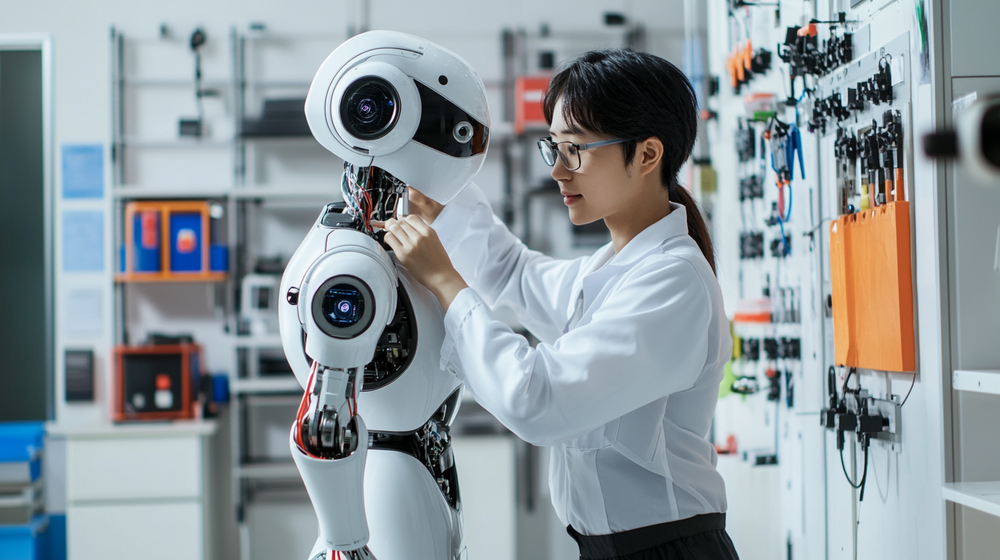
This article is from the WeChat public account:Chao Nian Ji, Author: Wei Wuhui II, Cover image from: AI generated
Famous investor Zhu Xiaohu’s views on humanoid robots recently sparked a small hotspot in the venture capital circle, leading to discussions among many industry professionals. As a result, this so-called robot marathon competition turned out to be a large-scale failure.
1
The human body structure is actually a very precise, complex, and even miraculous system.
A senior member of my family had an accident many years ago, resulting in a fracture in the pelvis. Later, a small piece of artificial bone was inserted. Although it was a very small piece of metal, the aftereffects are still evident: walking has a greater lateral sway than average people, due to balance. Climbing stairs is more laborious, due to the exertion required.
The human body is this precise; it is truly remarkable, and even a slight deviation is unacceptable.
2
No one has ever defined a shape for computers.
When the first general-purpose computer, ENIAC, was introduced, humanity could not have imagined that computers would evolve into their current form.
Subsequently, a display, a main unit, and keyboard and mouse peripherals became the standard PC shape.
The shape of laptops eliminated the main unit, hiding it beneath the keyboard.
Tablets are, quite simply, just a flat board.
No one has ever stipulated that computers must take a certain shape before developing them. In fact, it is the functions of computers that need to meet various demands, and the shape? It has merely evolved gradually to satisfy those needs.
3
This is what I mean when I say that humanoid robots lack imagination. They adopt a seemingly imaginative anthropomorphic shape, but in reality, this path completely restricts the development of robots.
So-called humanoid robots are nothing more than having a head, exactly two arms, exactly two legs or feet, and a torso.
Why must there be a head? Can’t visual and auditory functions be integrated into the torso?
Why must there be two arms? Wouldn’t three or even eight mechanical arms better meet functional needs?
Why must there be two legs? To enhance balance, wouldn’t three or four legs be better?
Ancient people could imagine three heads and six arms to represent great powers (i.e., completing more functions than ordinary people), and even the Thousand-Hand Guanyin displayed boundless magical power. Yet today, we impose a limitation on ourselves: it must look human!
This is a lack of imagination!
4
The primary goal of robots is to accomplish certain specific functions.
If only a few legs are needed to transport objects, why must there be only two legs? The balance requirement for two legs is very high, and they cannot overcome obstacles that are too high. To maintain balance, the load capacity cannot be too great. It is important to note that once you carry something weighing dozens or even over a hundred pounds, the entire balance system becomes more challenging.
On the battlefield or at disaster sites, mechanical dogs are relatively more suitable than humanoid robots—please note, this is only relative. Mechanical dogs have their own issues.
In scenarios with few obstacles, wheels have advantages over legs. Hotel robots do not need legs at all. The advantage of wheels is that the investment cost is extremely low, and there is basically no need to consider hydraulic systems. If they are sturdy enough and have sufficient power, carrying weight is not a major issue.
In areas that humans cannot easily reach but wish to operate in, such as the deep sea or outer space, insisting on creating humanoid robots is, in my opinion, a case of losing sight of the main goal.
Zhu Xiaohu’s assertion that humanoid robots currently lack application scenarios is actually correct.
What scenarios require a humanoid robot to accomplish tasks that a non-humanoid robot cannot do well?
5
Emotional value.
Once they are sufficiently humanoid, without considering the uncanny valley effect of not being able to fully replicate humans, they may provide emotional value.
For example, adult dolls with GPT inside are the sex robots seen in many sci-fi films.
I have explored this industry somewhat, and the reality is that intelligent adult dolls have higher requirements for joints (including load-bearing). I won’t elaborate further; it’s not suitable for children. Adults can imagine.
Moreover, I have always believed that the ethical issues in this direction are significant. Humanity’s own ethical issues are still hotly debated, and with animal protection issues added in, it becomes even more chaotic.
Another direction is elderly care, such as replacing caregivers.
However, caregiver replacement is largely functional: turning over, assisting with urination, accompanying to medical appointments, etc. Emotional aspects do not necessarily require humanoid forms. Wouldn’t it be possible to create an intelligent bird instead?
6
The humanoid robot track, due to its shape limitations, transforms what could be a solution to a few major problems into a series of unrelated, bizarre issues that need to be resolved.
Aside from applauding the ambition to conquer scientific peaks, I must say that the ROI is very unprofitable.
Machines are defined by their functions, which dictate their shapes, not the other way around.
This article is from the WeChat public account:Chao Nian Ji, Author: Wei Wuhui II
This content represents the author’s independent views and does not reflect the position of Huxiu. Unauthorized reproduction is prohibited; for authorization matters, please contact [email protected]. If you have any objections or complaints regarding this article, please contact [email protected].
End
Want to gain knowledge? Follow Huxiu’s video account!